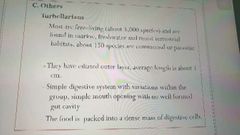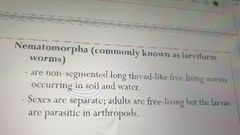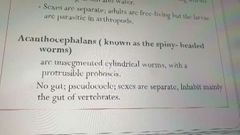![]()
![]()
![]()
Use LEFT and RIGHT arrow keys to navigate between flashcards;
Use UP and DOWN arrow keys to flip the card;
H to show hint;
A reads text to speech;
52 Cards in this Set
- Front
- Back
|
these are parasitic worms that can infect humans and other animals |
Helminths |
|
|
3 common types of Helminths |
1. Nematodes (round worms) 2. Cestodes (tapeworms) 3. Trematodes (fluke) |
|
|
2 phylum of Helminths |
Platyhelminthes and Nemathelminthes |
|
|
Platyhelminthes main characteristics |
- Three body layers: ectoderm, mesoderm and endoderm (acoelomate ;without a body cavity) - Main body structure: Acoelomate; dorso-ventrally flattened; bilaterally symmetrical; no anus - Mesoderm develops into a specialised connective layer known as the parenchyma. - The organs — reproductive, nerves, muscular, excretory etc, are embedded within the parenchyma - No specialised respiratory organs. Gaseous exchange is by diffusion through outer body layer. - Specialised excretory ‘organs’ known as flame cells unique to this phylum, these cells link into a tubular system for the removal of liquid nitrogenous waste. - Nearly all members of this phylum are hermaphrodite |
|
|
Platyhelminthes three body layers |
ectoderm, mesoderm and endoderm (acoelomate ;without a body cavity) |
|
|
without a body cavity |
acoelomate |
|
|
Platyhelminthes Main body structure (4) |
Acoelomate; dorso-ventrally flattened; bilaterally symmetrical; no anus |
|
|
Platyhelminthes Mesoderm develops into a specialised connective layer known as the ____ |
parenchyma |
|
|
The organs of Platyhelminthes — (4) etc, are embedded within the _____ |
reproductive, nerves, muscular, excretory; parenchyma |
|
|
Platyhelminthes has no _____. Gaseous exchange is by ______ |
specialised respiratory organs; diffusion through outer body layer. |
|
|
Specialised excretory ‘organs’ known as ____ unique to this phylum, (what is its function) |
flame cells; these cells link into a tubular system for the removal of liquid nitrogenous waste. |
|
|
Nearly all members of this phylum (Platyhelminthes) are ____ |
hermaphrodite |
|
|
Cestodes characteristics |
- A unique feature of this group is that the adults only occupy one type of habitat — the gut or derivatives such as the bile duct or pancreatic duct of a vertebrate - All adult forms are endoparasites inhabiting the gut or gut derivative of a vertebrate - They have no ciliated epidermis and no alimentary canal (gut) -The adult form is divided into segments known as proglottids. - The anterior end, the ‘head’, is known as the scolex and has well developed adhesive organs. |
|
|
unique feature of cestodes |
the adults only occupy one type of habitat — the gut or derivatives such as the bile duct or pancreatic duct of a vertebrate |
|
|
All adult forms of cestodes are ____ inhabiting the gut or gut derivative of a vertebrate |
endoparasites |
|
|
Cestodes don’t have (2) |
They have no ciliated epidermis and no alimentary canal (gut) |
|
|
The adult form of cestodes is divided into segments known as ____. |
proglottids |
|
|
The anterior end of cestodes, the ‘head’, is known as the ____ and has ____ |
scolex; well developed adhesive organs |
|
|
TREMATODES (commonly known as flukes) characteristics |
- Two main orders: the Digenea and the Monogenea. - No cilia on outer layer (known as tegument) and is a living layer that helps to absorb nutrients - Body is undivided and has a mouth opening into a pharynx, esophagus and then gut with a bi-lobed blind- ending diverticula (alimentary canal). - Most species are hermaphrodites except for the Schistosomatidae - All have well developed adhesive organs. |
|
|
Two main orders of trematodes |
the Digenea and the Monogenea. |
|
|
Outer layer of trematodes |
No cilia on outer layer (known as tegument) and is a living layer that helps to absorb nutrients |
|
|
Trematodes - Body is ___ and has a ___ opening into a ______________ |
undivided; mouth; pharynx, esophagus and then gut with a bi-lobed blind- ending diverticula (alimentary canal). |
|
|
Trematodes - Most species are ____ except for the _____ |
hermaphrodites; Schistosomatidae |
|
|
Trematodes all have well developed _____ |
adhesive organs |
|
|
Nematodes (commonly known as round worms) characteristics |
- have three body layers with a body cavity known as the pseudocoelom. -The body cavity is fluid-filled and forms a hydrostatic skeleton. - Cylindrical body shape, non-ciliated outer layer known as a cuticle. - Sexes are separate; the gonads are tubular and with their ducts form a continuous structure. - Worldwide distribution; occupying both terrestrial and aquatic habitats. |
|
|
Nematodes (commonly known as round worms) have three body layers with a body cavity known as the ______. |
pseudocoelom |
|
|
Nematodes body cavity |
body cavity (pseudocoelom) is fluid-filled and forms a hydrostatic skeleton. |
|
|
Nematodes body shape and outer layer |
Cylindrical body shape, non-ciliated outer layer known as a cuticle. |
|
|
Reproductive glands of nematodes characteristics |
Sexes are separate; the gonads are tubular and with their ducts form a continuous structure. |
|
|
Nematodes - Worldwide distribution; occupying both (2) |
terrestrial and aquatic habitats. |
|
|
3 other helminths |
Turbellarians, Nematomorpha (commonly known as larviform worms), Acanthocephalans (known as the spiny-headed worms) |
|
|
Turbellarians |

|
|
|
Nematomorpha is commonly known as |
larviform worms |
|
|
Nematomorpha (commonly known as larviform worms) |

|
|
|
Acanthocephalans (known as the spiny- headed worms) |

|
|
|
Acanthocephalans are known as the |
spiny-headed worms |
|
|
Nematodes - sexes find each other with ____ |
pheromones |
|
|
Nematodes - male sperm lack ___ (move by ___) |
flagellum; pseudopodia (major sperm protein) |
|
|
Nematodes in Small Intestine (4) |
1. Ascaris lumbricoides (large roundworm) 2. Hookworms: Ancylostoma duodenale and Necator americanus 3. Strongyloides stercoralis (dwarf threadworm) 4.Capillaria philippinensis |
|
|
Nematodes in Large Intestine (2) |
1. Trichuris trichiura (whipworm) 2. Enterobius vermicularis (pinworm) |
|
|
Nematodes in Small Intestine (4) |
1. Ascaris lumbricoides (large roundworm) 2. Hookworms: Ancylostoma duodenale and Necator americanus 3. Strongyloides stercoralis (dwarf threadworm) 4.Capillaria philippinensis |
|
|
Nematodes in Large Intestine (2) |
1. Trichuris trichiura (whipworm) 2. Enterobius vermicularis (pinworm) |
|
|
Intestinal Nematodes maintains its position in its habitat by (4) |
1. Oral attachment (Hookworm) 2. Anchorage with their attenuated ends (Trichuris) 3. Penetration to the tissues (Strogyloides) 4. Retention on the folds of the mucosa (Ascaris) |
|
|
Nematodes Methods of Obtaining food (4) |
1. Sucking and ingestion of blood (Hookworm) 2. Ingestion of lyzed tissues 3. Feeding on intestinal content 4. Ingestion of nourishment from body fluids |
|
|
phylum nematoda - how many in 1 rotting apple - how many in 6.7 ml of coastal mud - estimated how many in good farmland |
90,000 1,074 9 billion per acre |
|
|
nematodes aka |
white worms |
|
|
nematodes that have curved posterior end |
males |
|
|
larger nematode |
females larger than males |
|
|
development from the egg of nematodes include (2) before the adult stage is reached |
4 larval stages and 4 moltijg |
|
|
some species of nematodes require an intermediate host to complete development like |
capillaria philippinensis |
|
|
point of entry of intestinal nematodes |
chemo-receptors |
|
|
chemo-receptors of nematodes |
cephalic or amphids (head end) caudal or phasmids (tail end) |

